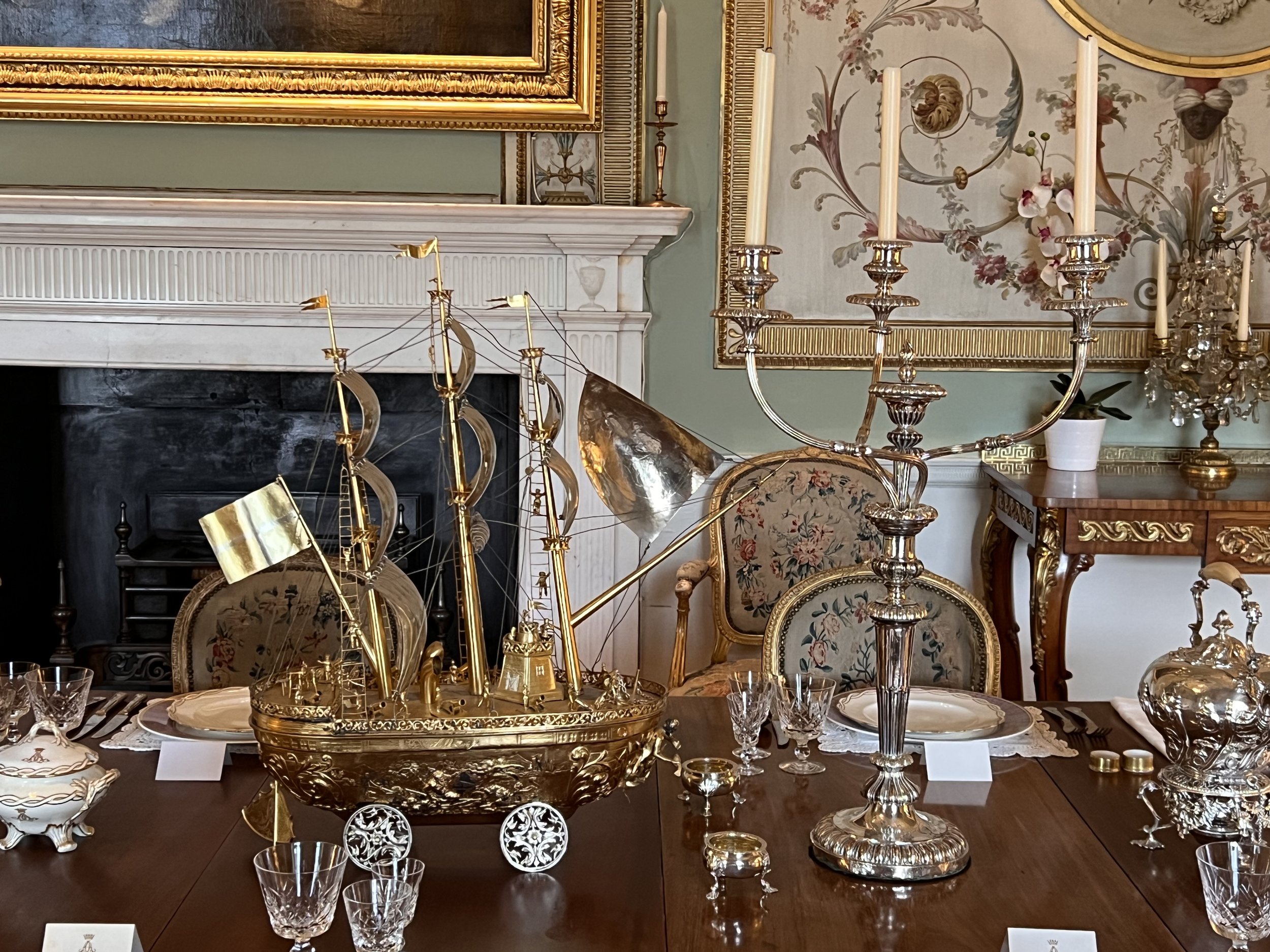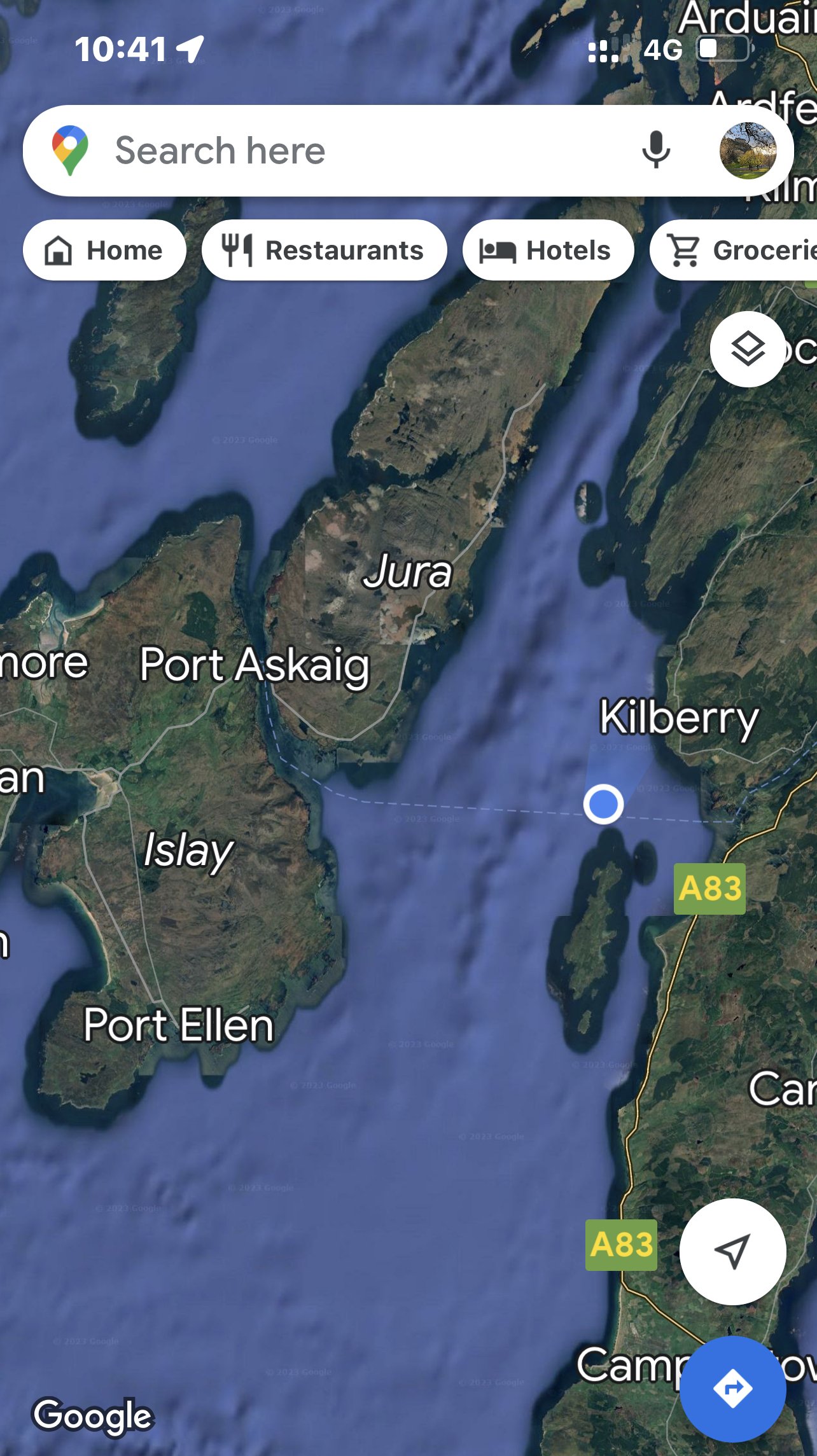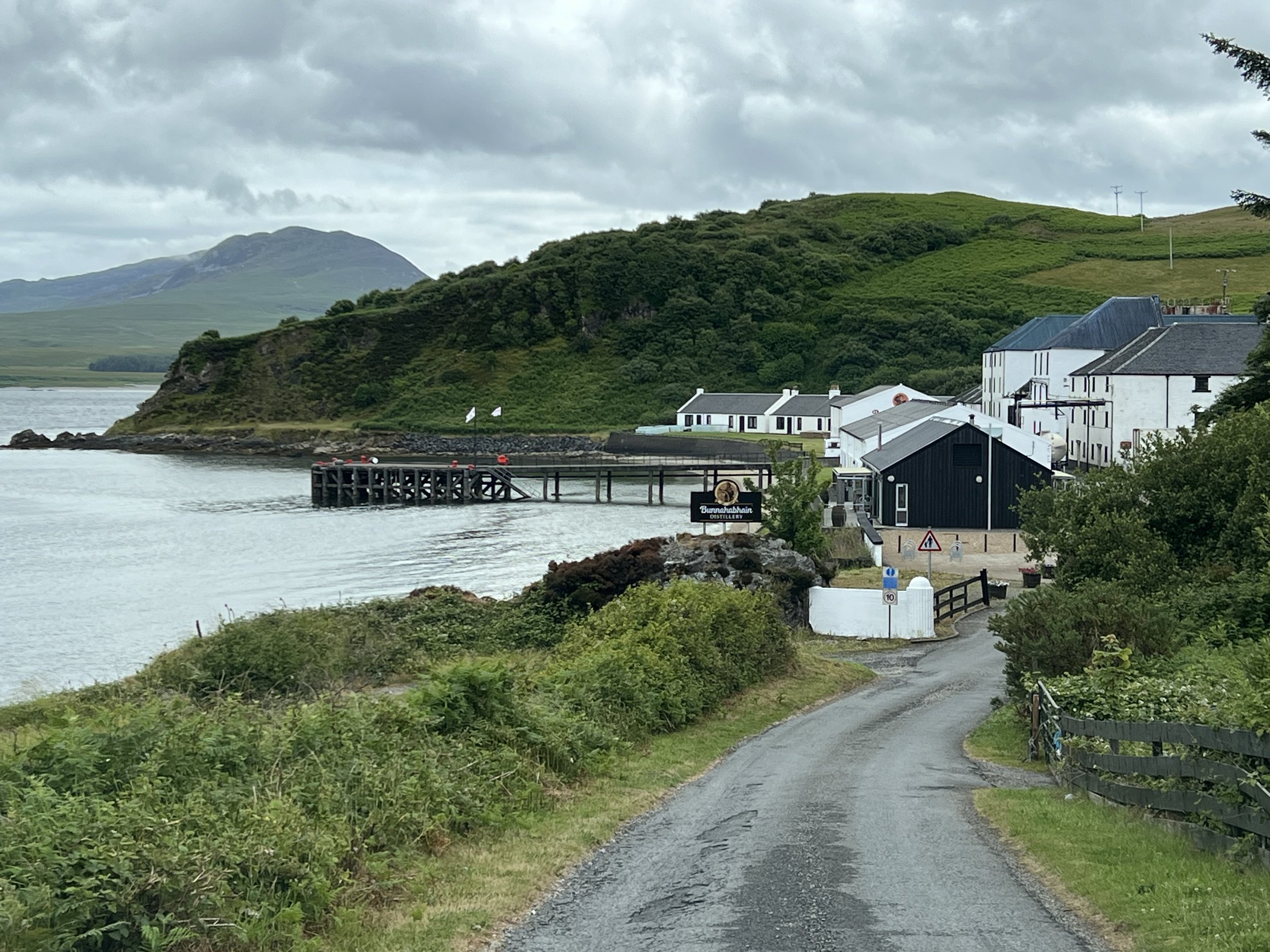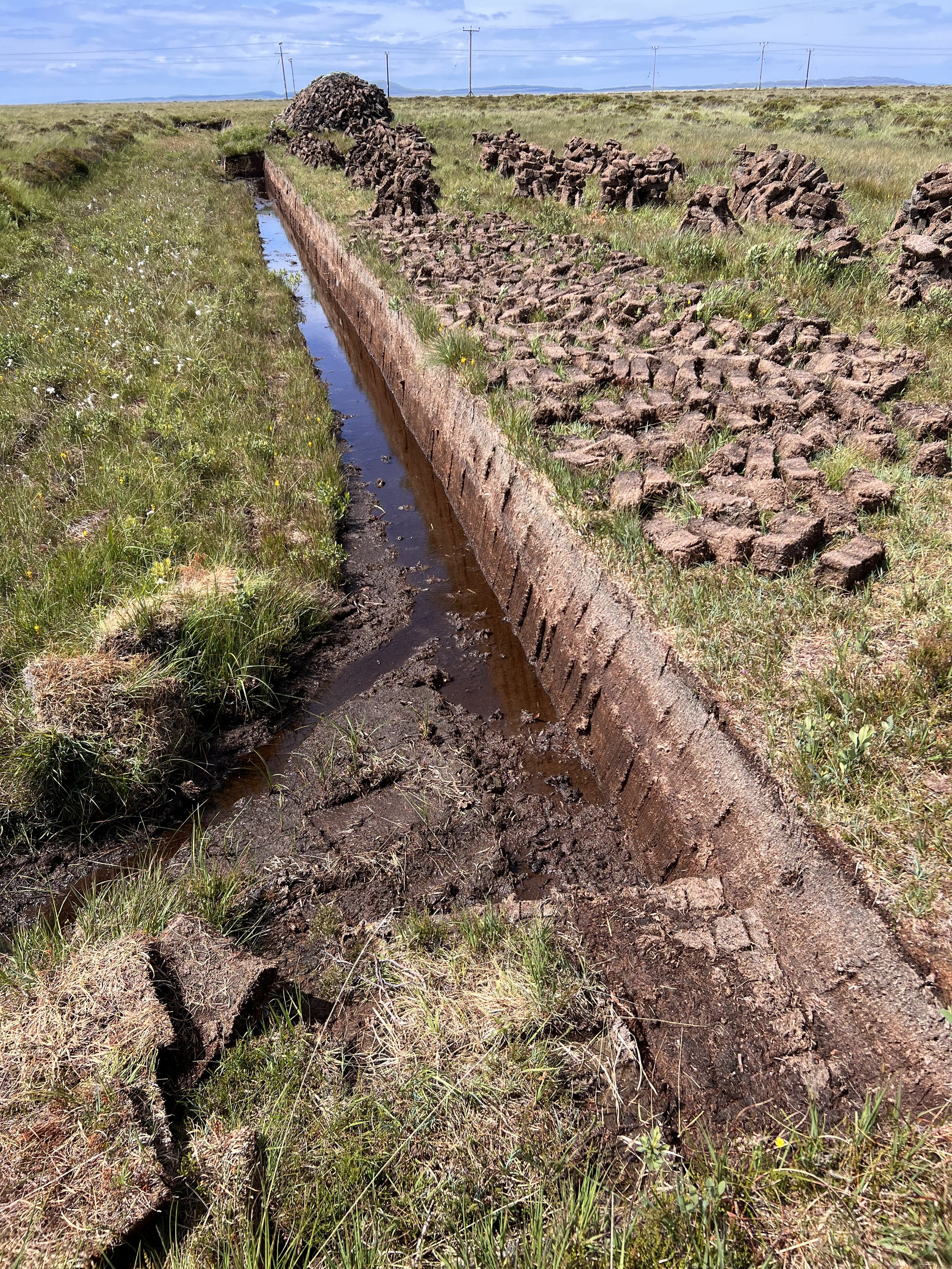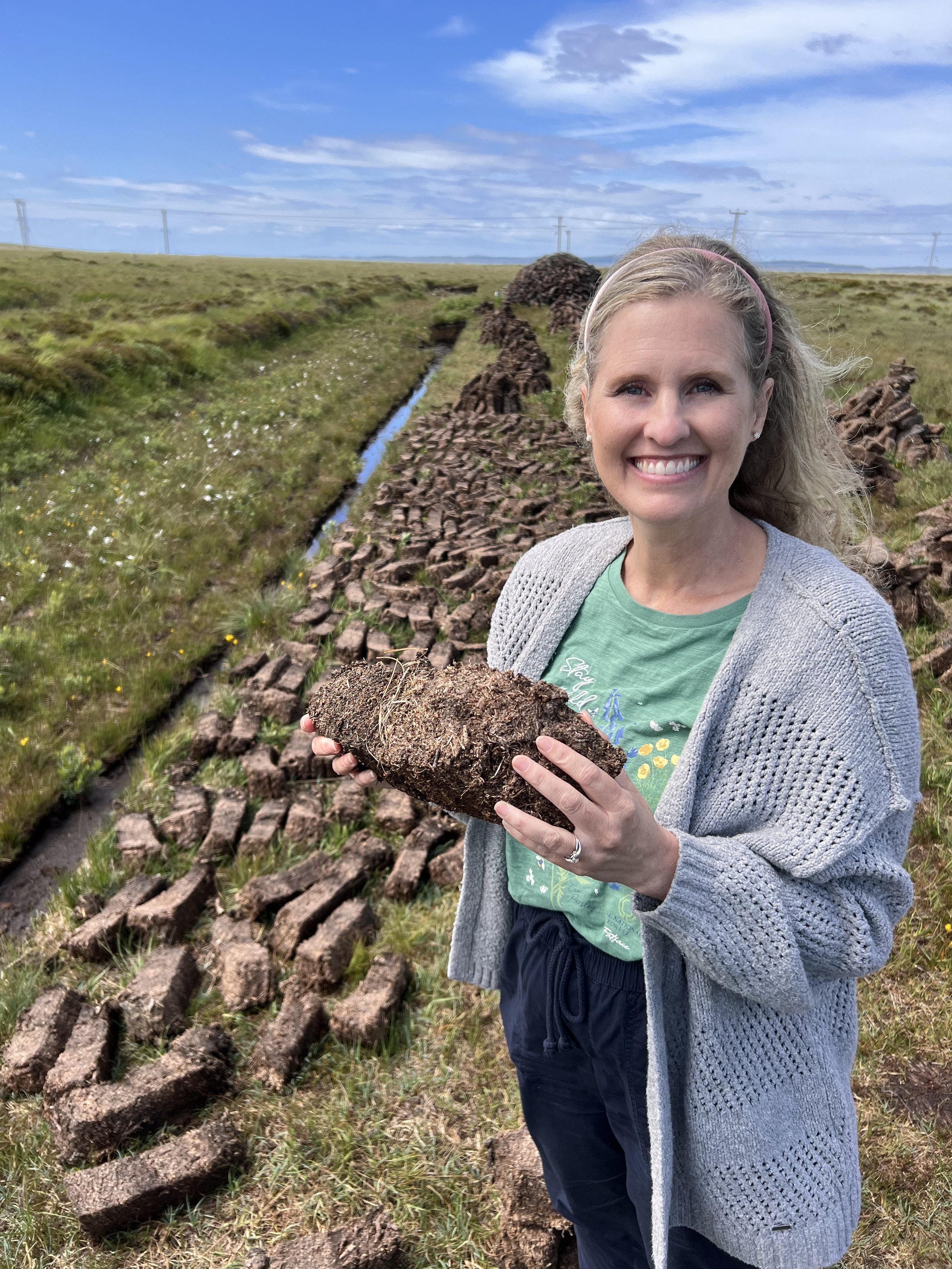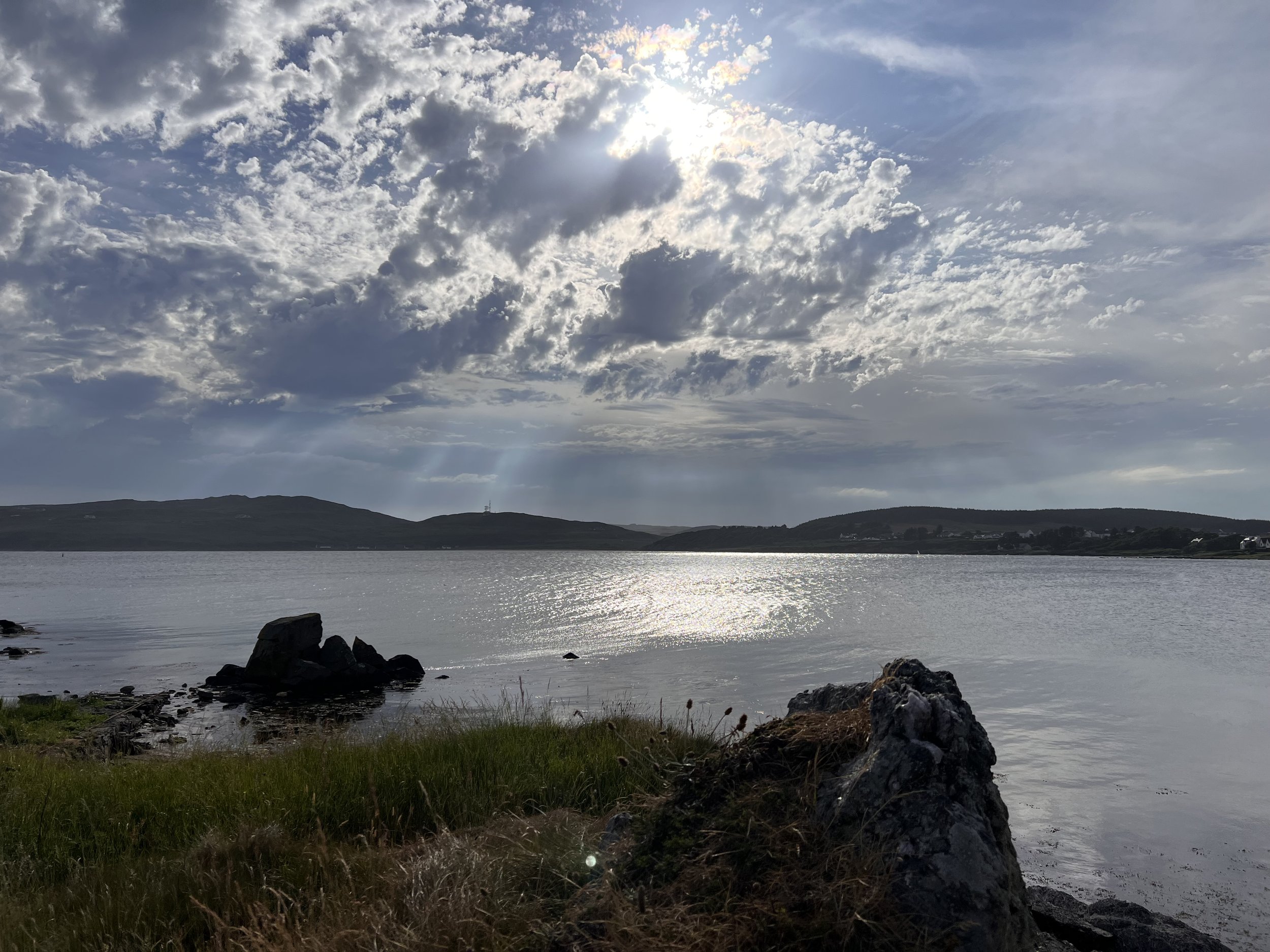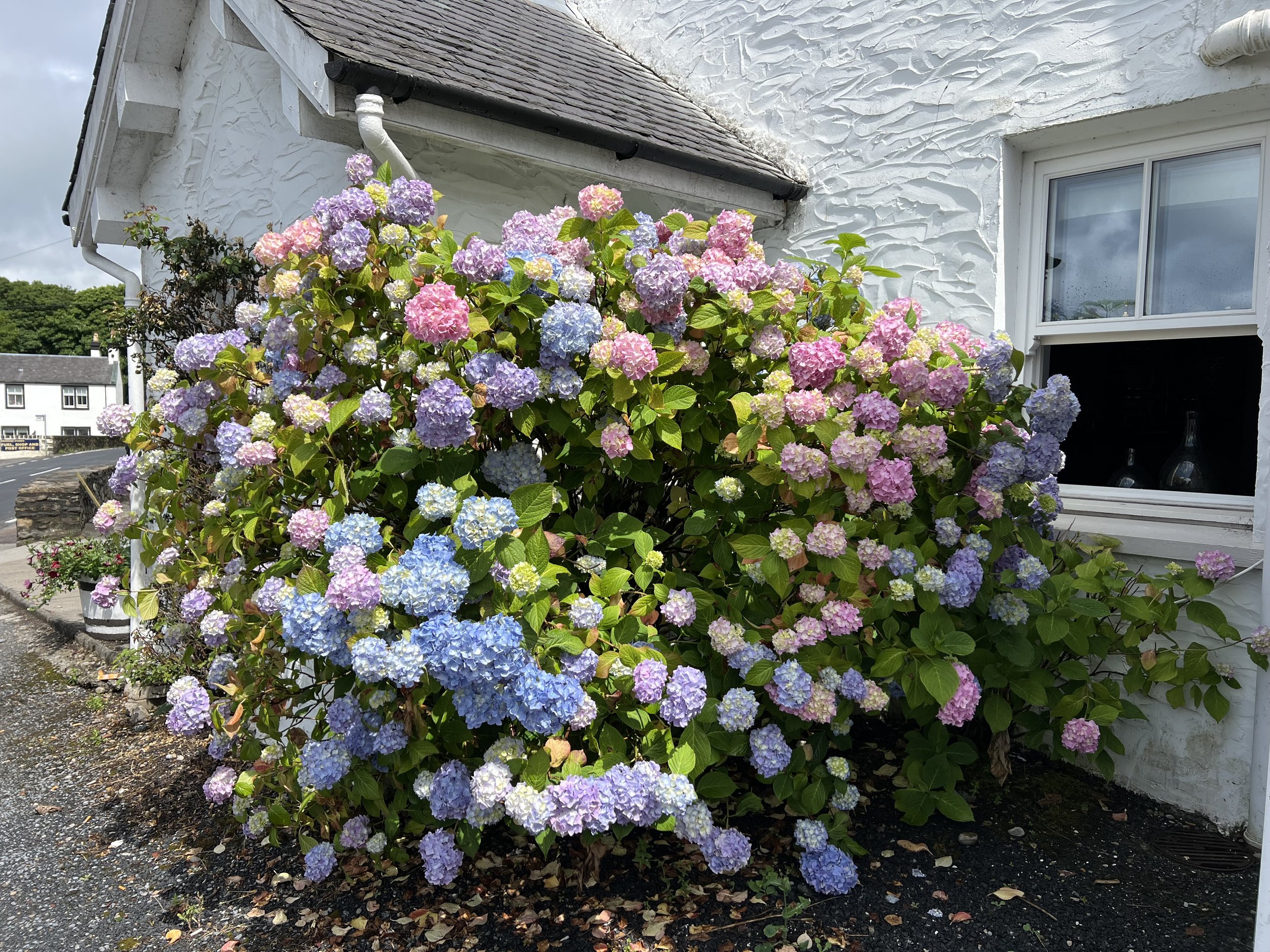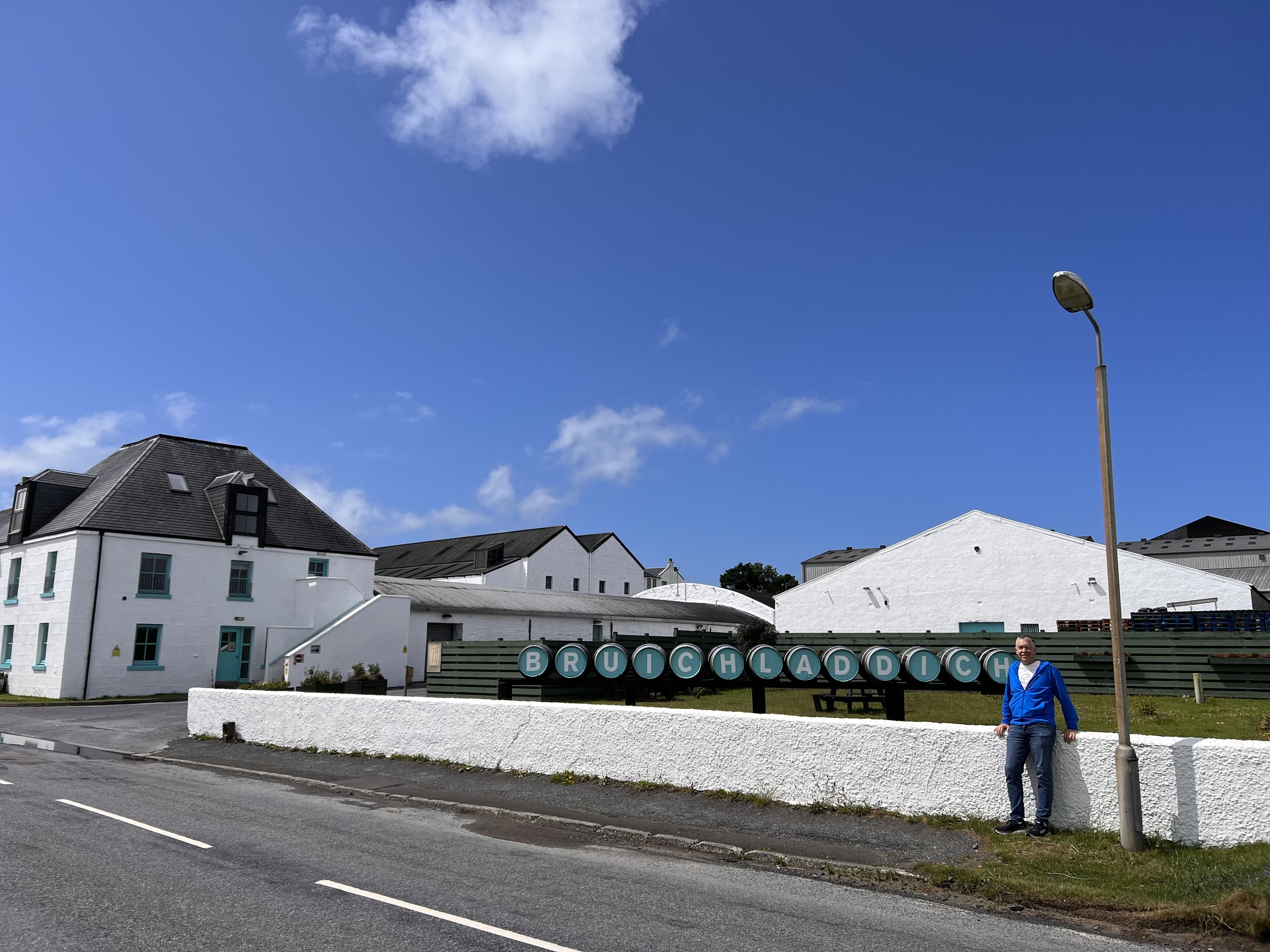Islay
“The passion. It’s all about the passion. People make this and they make that, but if it’s not made with passion, then it is only a mere shadow of what it could be.”
A Wee Scottish Blessing
We took a bit of a risk when we booked our stay in Glasgow at the Native Glasgow hotel. It turned out to be a great decision and we highly recommend staying there should you ever venture to the city.
Probably the only downside was they had no on-site parking. It’s only a four-minute walk from the nearby parking structure, but if it’s pouring rain, than that’s a l-o-n-g walk.
It did rain quit hard during our visit, but we were fortunate to have only light rain when we were moving suitcases.
However, the only way to receive discounted pricing on parking is to have the app for the company that runs the parking structure.
One thing we’ve learned on this trip is that the Apple App Store “knows” where your phone is based. Even though I have a dual-SIM phone with a UK eSIM, it still sees the USA SIM as the primary. So, even when I change the Region on the phone to the UK, the phone will still only populate apps that are used in the USA.
The error message I received when I tired to download the NCP parking app.
So, I was prevented by the phone from downloading the NCP parking app that would reduce our daily parking charge from £20/day (≈$26) down to £12/day (≈$15). The hotel said there was nothing they could do.
We arrived early at the parking garage, and were very fortunate to find two NCP workers who were very helpful. They took our parking ticket, entered it into their computer, and applied the reduced rate!
Right after we left them, look what happened…
A wee Scottish blessing.
Inveraray Castle
Inveraray Castle was about an hour and a half drive north of Glasgow. What can we say about the drive? This is the Scotland you see on TV and in the brochures! I’ve been holding the word in reserve after getting so much grief from some of you, but here it comes again…wait for it…
STUNNING! Absolutely gorgeous! Died and gone to heaven! Pinch me; am I dreaming? Beautiful beyond words!
It rained most of the way, so there were low, wispy clouds hugging the mountain tops and vistas across mysterious blue-grey lochs at every turn.
Loch Lomond (sing along: “…The Bonnie Banks of Loch Lomond”), Loch Long, Loch Goal, and Loch Fyne. I guess the term “loch” is rather loosely applied in the west. Many of these “lakes” are in fact not lakes at all but long inlets off the North Atlantic Ocean. Whatever you call them, they are certainly majestic.
On the shores of Loch Fyne sits Inveraray Castle, the home to the Duke & Duchess of Argyll.
To put that into more traditional Scottish terms, the family is part of Clan Campbell, and the castle rests squarely in Campbell lands.
I don’t know why I never put it together, but—yep!—one and the same.
Probably more importantly, it is where they filmed the 2012 Downton Abbey Christmas special (nearly every show worth its salt in the UK will do a Christmas special!).
In the special, the family headed to the Scottish Highlands to stay at the fictional Duneagle Castle—which was actually Inveraray Castle.
Above: Amanda and her beloved character Matthew Crawley (Dan Stevens). I much prefer him as Alexander Lemtov, the Lion of Love, in Eurovision.
The extravagant State Dining Room looked in the Downtown Abbey special much as it does here.
The elaborate painting throughout the room was completed in 1784 by two French artists Girard and Guinand, whose work only survives at Inveraray.
If you go back and watch, even the gold galleons were in the special.
The Tapestry Drawing Room, exquisitely decorated in the Parisian style and representing the most sophisticated tastes of the 1780s.
The entrance to the China Turret from the Tapestry Drawing Room is ingeniously concealed by a pair of double doors covered with tapestry panels integrated into the design of the drawing room.
Armory Hall
The old kitchen.
Stonefield Castle
A bucket list item for this trip was to spend one night in a castle. For a variety of reasons, Stonefield Castle was the only one that really worked out.
Stonefield Castle was built in 1837 in the Scottish baronial style. Like virtually everything else on this peninsula, the estate was owned by a Campbell. We’re not sure a house that is only 186 years old can truly qualify as a castle, but we’ll just accept their title because it suits our needs. 😙
You can see the castle’s location on the map below. While you’re there, you can pan to the left and see the island of Islay, where we’re headed tomorrow.
We had to leave our hotel in Glasgow this morning too early to have breakfast, so the moment we settled into our room at Stonefield Castle, we broke out the tea, biscuits, crumpets (remember we’re now the proud owners of a charity shop rescue toaster!), Scottish potato scones, and our new frother. Cue Young Sheldon—afternoon tea is served!
After tea, I headed down to the bar and grabbed a dram of a peated Ardbeg whisky. Then it was off to one of the many lounge areas to find a quiet nook—such a deeply atmospheric place to read and enjoy a wee dram.
The castle sits on the shores of Loch Fyne.
The dining room with panoramic views across the forest and loch.
So bougie! We really don’t have the clothes with us to play the part properly, but the food was exquisite! It’s hard to tell, but there’s a fancy tart under all the frou-frou.
Dessert
Islay
The small island of Islay (EYE-la) is famous for one thing—whisky, and in particular, whisky made from barley dried under smokey peat fires.
You may recall way back from a post I did when we were in Edinburgh, that American and Irish liquor producers favor the spelling “whiskey,” while Scottish, Canadian, and Japanese producers favor the spelling “whisky.”
Waiting for our ship to come in at the Kennacraig Ferry Terminal.
Lord of the Isles
Nearly all of the ferries operating in the Western Isles are double-sided. We drove in the front, and when we arrived on the island, the captain used the contra-rotating propellers to spin the ship 180-degrees and then docked stern-first so the cars could drive straight off the stern of the vessel. Pretty impressive!
The journey to Port Askaig Ferry Terminal took about and hour and a half. The mainland behind me.
Finally out into the open channel. You can see from the dashed blue line to the right of our location circle, that the Kennacraig Ferry Terminal is pretty far up the inlet, so it takes a while to hit the open seas. It was actually a very pleasant day and smooth sailing the whole journey.
Bunnahabhain Distillery
The ferry arrived at noon and we drove straight to Bunnahabhain (pronounced BOO-ne-HAV-in) Distillery (say that 5 times fast!).
Bunnahabhain, from Gaelic meaning “foot of the river,” on the northeast coast of Islay, is the name of the bay, the tiny village, and the distillery.
Such a beautiful setting at the northern tip of Islay. The hill in the distance is the neighboring island of Jura. The Sound of Islay is a narrow strait between the islands of Islay and Jura.
Ardnahoe Distillery
Don’t worry, we just stopped in Bunnahabhain and Ardnahoe to check out the merch, because you can only drink so much whisky in one day, and we had a tour scheduled at Laphroaig Distillery at 2:30.
Jim McEwan MBE retired from the whisky industry in July 2015 after a prodigious career that began in 1963, and later saw his name become synonymous with both Islay and the Scotch whisky industry.
Eighteen months after he retired, Jim took the position of Production Director of Ardnahoe, the first distillery to be built on Islay for more than a decade.
Jim spent 38 years in a variety of roles at Bowore, the distillery he first joined as a 15-year-old apprentice cooper in 1963. During his career there, he worked in every aspect of the distillery, from warehousing and cellar master, to trainee blender, distillery manager, and Global Brand Ambassador. You can learn a lot more about Jim and Islay whisky by watching the documentary Scotch: A Golden Dream (2018).
He was then Master Distiller at Bruichladdich Distillery for 15 years before retiring (well, kind of).
“...when I visited the [Ardnahoe] distillery...it absolutely blew me away. It’s an incredible spot up on a hill overlooking the Sound of Islay out to Mull in the north and across to Jura—it has to be one of the most beautiful sites for a distillery anywhere in the world.”
On our drive down to Port Ellen, we passed this peat bog and stopped to check it out.
This is the real deal baby, carved from the earth one hand shovel full at a time.
The seaweed, tar, and iodine so typical of Islay malts are partly due to decomposed marine vegetation and sea salt in the island's peat.
Laphroaig Distillery
Then it was on to the star of the show—our tour at Laphroaig Distillery.
The day may have started grey and rainy, but by the early afternoon, it transformed into a gorgeous summer day. And what commanding real estate Laphroaig owns!
If you’ve watched the documentary Scotch: A Golden Dream, then you’ll have seen Laphroaig.
How Whisky is Made:
Barley—The grain for making whisky. Harvested barley has a natural resistance to growth known as dormancy, so the seed must be tricked into thinking it’s spring, thus encouraging the barley to start to grow (germinate).
Steeping—The barley is coaxed into growing by a series of immersions in warm water over the course of around two days; this process is known as steeping.
Germination—After steeping, the grain is spread out evenly and encouraged to germinate. The “Green Malt” is turned regularly to keep the grains cool and separate. This ensures an even rate of growth. As the barley germinates, enzymes created turn the starch inside each grain into sugar. It is sugar that is needed later to make alcohol.
The thermometer sticking up from the grain helps monitor the temperature of the grain and control growth.
Laphroaig is one of only a handful of distilleries that still have their own malting floor and that turn the grains by hand. Note the sprouting of the grains.
If you watched Men in Kilts S1:E1, the malting floor at Laphroaig should look very familiar!
After about six days on malting floor, the barley is all pushed down this hole in the floor.
Kilning—To arrest germination, the “green malt” is dried by heating, a process known as kilning.
What makes Islay whisky so unique is that is that during the kilning process, the barley is heated by peat fires.
All peat fires produce smoke, but the drier (and lighter) peat is used for heating while the wetter (much heavier) peat is used to produce an even more smoky fire.
We visited on a Saturday and they don’t run their kilns on the weekends., which is too bad because you miss the peat fire smell in the air (believe me, you can still smell it though).
This fire is stacked and ready to go for Monday. When we visited the Jameson Distillery in Middleton, Ireland, they explained how they burn anthracite grains smokeless fuel so their barley does not acquire any smokey flavoring.
The advantage of it being the weekend is you can actually go inside the kiln.
The “green (sprouted) malt” is spread across this highly perforated floor and the peat fire lit below. The heat arrests germination and reduces water content.
Of course the barley absorbs the smokinesses from the peat fire below. The slope of the kiln’s roof and fan are designed to create a low pressure area, drawing the smoke from the fire, through the grain, and then out from under the pagoda.
A common feature of distilleries is the pagoda-style roofs over their kilns.
Obviously, the longer the malt is exposed to peating, the peatier the whisky will be. Typical flavors imparted by peat smoke phenols include: vegetal, medicinal, carbolic, tar, creosote, clove, and seaweed.
The amount of peatiness, or “peat reek” of malted barley is measured and expressed in parts per million (ppm) of phenols, the flavor element imparted by the peat smoke. Each distillery specifies a specific peat level to be supplied by its maltster; traditionally distilleries on Scotland's west coast use more peat reek than those in Speyside and the east coast.
As examples: Bruichladdich Octomore uses 167 ppm, Ardbeg 50 ppm, Lagavulin 30 ppm, Talisker & Highland Park 20 ppm, and typical Speyside malt uses 2 ppm.
Fermentation—The washback is a large container called a mash tun that can be thought of as the tea pot of the distillery. This is where yeast is added and all the alcohol finds its way into the whisky.
Fermentation continues for between 2 and 4 days.
Distillation—To turn the wash into spirit, it needs to be distilled. Distillation is when a liquid is heated until boiling and the resulting vapors are collected.
At Laphroaig, distilling is a two-stage process, as it is at the majority of distilleries in Scotland.
You may recall from Jameson bottles that they are triple distilled. The lack of smoke and the triple distillation process makes Jameson a generally “smoother” spirit.
The wash stills carry out the first distillation.
The spirit stills carry out the second distillation.
Sam Heughan and Graham McTavish visit Laphroaig’s stills on the Men in Kilts episode.
Maturation—Then it’s off to mature in oak casks or barrels. Above are European sherry barrels, American oak bourbon barrels, and a quarter casket (which is an American barrel disassembled and reassembled into a smaller size to create greater wood contact and expedite the maturation process).
By law, to be considered whisky, the spirit must mature in the cask for a minimum of three years.
Finally to the best part, the tasting. Amanda had Lore, Select, and Quarter Cask. Her favorite was the Select and she found the Quarter Cask a bit too sweet.
I had Lore, Batch 11, and Batch 14. Maybe it’s all those years camping in the Boy Scouts, but I’ve found I really enjoyed the peaty (Batch 11) and smokey (Batch 14) offerings. If I had to pick, I would choose Batch 11.
Blessed beyond measure not only to be here, but to be here with a great friend and to have been gifted with such a beautiful day!
A parting shot of Sam and Graham at Laphroaig.
We stayed at the Islay Hotel in Port Ellen. You’re on a small island (and a touristy one at that), so this was not a cheap night (roughly $350), but we were talking to someone on the tour and his place sounded horrible. I’m glad we bit the bullet to ensure we stayed in a descent hotel—and the Islay Hotel was a great choice.
Like I said, Saturday really turned into a beautiful day!
The Islay Hotel is the taller white building with the tree dormer windows just left of center on the other side of the bay. Port Ellen is a really picturesque town.
Lagavulin Distillery
On Sunday, we stopped in the Lagavulin shop to have a quick look around.
Dunyvaig Castle at the end of the peninsula from Lagavulin Distillery.
Unless we hiked out to the castle, there was no way to get a good shot of the distillery, so we’ll have to settle for the above stock image (which, let’s face it, is better than any photo I was going to take).
Ardbeg Distillery
As it was Sunday, several of the distilleries were closed, and Ardbeg happened to be one of those. Here are a few shots anyway.
My Mary Poppins!
We thought these were pretty clever.
Kildalton Cross
Several miles past the Ardbeg distillery is this old church ruin.
Carved about 1,300 years ago, this is one of the finest and most complete early Christian crosses in Scotland.
We were getting attacked by Highland midges, so time to go…
Bowmore Distillery
Bowmore was closed, so we’ll just settle for a selfie and the stock image below. 😊
On our way to the next distillery (Bruichladdich!), Amanda spotted this hydrangea bush in front of Bridgend Restaurant & Katie's Bar and we had to pull over to snap a shot. We’ve never seen one multicolored like this before. It was so beautiful!
Amanda was in hydrangea heaven!
Wow!
Bruichladdich Distillery
Bruichladdich is one of our favorites, so we were really looking forward to our tour of the distillery today.
In 2001, the owners of Bruichladdich were flying to Islay and— noticing the color of the shallow water around the island on a sunny day—decided to adopt that blue as their branded color.
Bruichladdich is a very old distillery and this massive belt-driven milling machine shows how in many ways they still produce their whisky as they did back in 1881.
This open-top cast-iron mash ton is a rarity in the industry. The ground malt (grist) enters the tank from the copper pipe at the top of the photo. Temperature-controlled water is added and removed in order to extract the fermentable liquid, known as wort, from the mash. Every single bottle of Bruichladdich ever made has spent time in this ton.
Ugly Betty is an old Lomond Still they converted for making The Botanist Islay Dry Gin.
Whereas whisky will not be ready for three years at the very soonest, gin is ready for consumption immediately following distillation. Making and selling gin allows Bruichladdich the opportunity to make money in the short-term while their whisky matures.
Did you happen to the notice the “Bruichladder” in this photo? Scroll back up and take a look. So funny!
Bruichladdich essentially steeps these 22 locally foraged botanicals in their gin before distillation. As the vapors make their way up the neck, they pass through the large cylinder at the top, which adds specific botanicals to that batch.
The original design of the Bruichladdich stills with taller, narrower necks, still in use today, help to produce a slightly more viscous (oily) whisky.
The Spirit Safe where they separate and test the “head, heart, and tail” of the whisky.
In Scotland, “traditional” often means dunnage warehouses, with barrels stacked no more than three high. These single-floor warehouses, with earthen floors and stone walls, regulate temperature and humidity naturally. In a country with minimal seasonal variance, the climate inside the warehouse remains consistent, which allows for slower, longer aging.
34 years and counting!
16 years ain’t bad.
This cask had a former life holding Jim Beam bourbon whiskey in Clermont, Kentucky before coming to Islay.
At the end of the tour we tasted their festival whisky, a Port Charlotte, and an Octomore. We learned they have a trick with their naming convention: a Bruichladdich label will be unpeated, Port Charlotte (the port nearest Bruichladdich) will be heavily peated, and Octomore will be super heavily peated (137.3 ppm).
A major insight I gained was that only a few scotch whisky distilleries do their own malting. On Islay, only Laphroaig, Bowmore, and Kilchoman malt their own barley on the island using Islay peat.
Bruichladdich, as do many of the Islay distilleries, sends their barley to mainland Scotland to be malted. That means that only Laphroaig, Bowmore, and Kilchoman are smoked with peat harvested on Islay.
Which is to say, when I had my dram of Octomore—the whisky with the highest peat concentration of any Islay whisky on the market—it was noticeably less peaty (to me) than the Laphroaig Batch 11 and 14.
Now I know, that’s because the peat from Islay is dramatically different from the peat found on the mainland. The mainland peat lacks the seaweed, iodine, salt air, moss, heather and sedges influences found on Islay. If you really enjoy that super peaty flavor in your Islay whisky—Laphroaig, Bowmore, and Kilchoman are your best options. I can’t speak to Bowmore or Kilchoman, but I really loved Laphroaig!
We met the two Chinese men during our Laphroaig tour. We saw them again before this tour and chatted for a bit.
Apparently the guy on the right is the owner and the guy on the left the distiller (Wu Hao perhaps?) for Lanzhou Distillery in Shanghai, China.
It’s a nascent market, so perhaps one day we’ll be able to say we met them when they were on the verge of introducing Chinese whisky.
Apparently the house of the right belongs to Jim McEwan. It’s literally the house closest to Bruichladdich.
Before catching our ferry back to the mainland, we stepped across the street from Bruichladdich and had lunch looking over Loch Indaal toward Bowmore Distillery on the opposite shore. What a beautifully perfect day!
Looking toward Bruichladdich.
Onward To Oban
Back on the ferry at Port Askaig (Islay) headed toward the Kennacraig Ferry Terminal on the mainland.
We’ve known for some time that this would be a long day. Our ferry did not leave until 6 pm and arrived back in Kennacraig at 7:30 pm. Ultimately we were not on the highway again until 8 pm.
Google maps estimated our arrival time at our hotel in Oban as 9:30 pm.
Fortunately, the roads were empty and the drive was gloriously beautiful. We knew the Scottish Highlands would be amazing, but nothing prepared us for the lush forests of deep green, the grandness of the topography, and the setting sun sparkling across loch after loch.
We expected Ireland—the Emerald Isle—to be the greenest place on our itinerary, but the Highlands beat Ireland hands down.
We were the only car driving through the forest when we suddenly saw a badger pop up from the right shoulder! He took one look at us and scurried back into the vegetation. Neither of us have ever seen a badger before.
As if the badger wasn’t enough, a few minutes later, a fox appeared out of the vegetation on our side of the highway before quickly disappearing again.
I don’t think I’ve ever worn sunglasses at 9:30 at night—not because my future’s so bright—but because I actually needed them. I guess sometimes it’s nice that the sun stays up so late.
Tomorrow we’re off to the Isle of Mull and it will be Amanda’s 48th birthday! It will be a great day!












